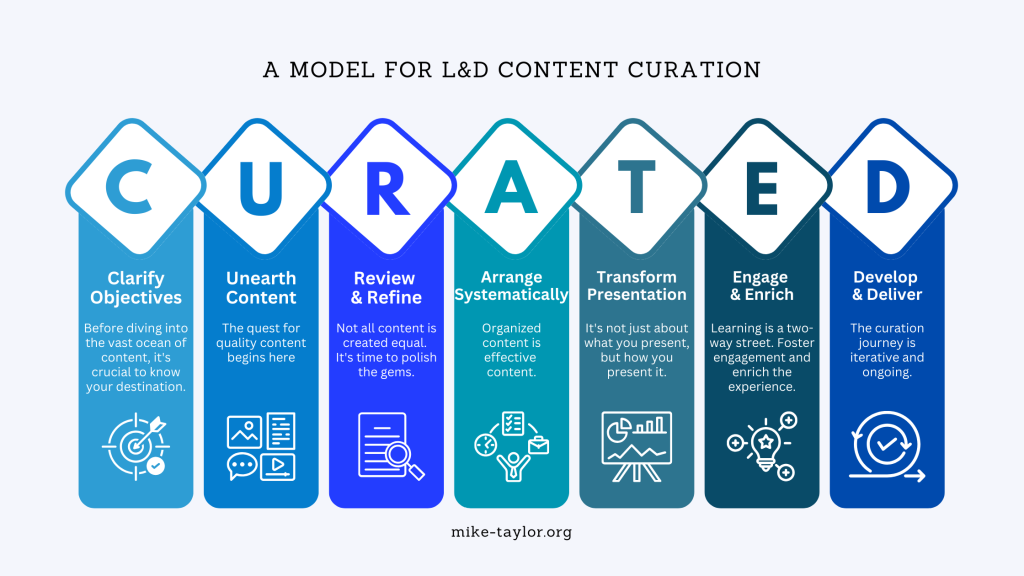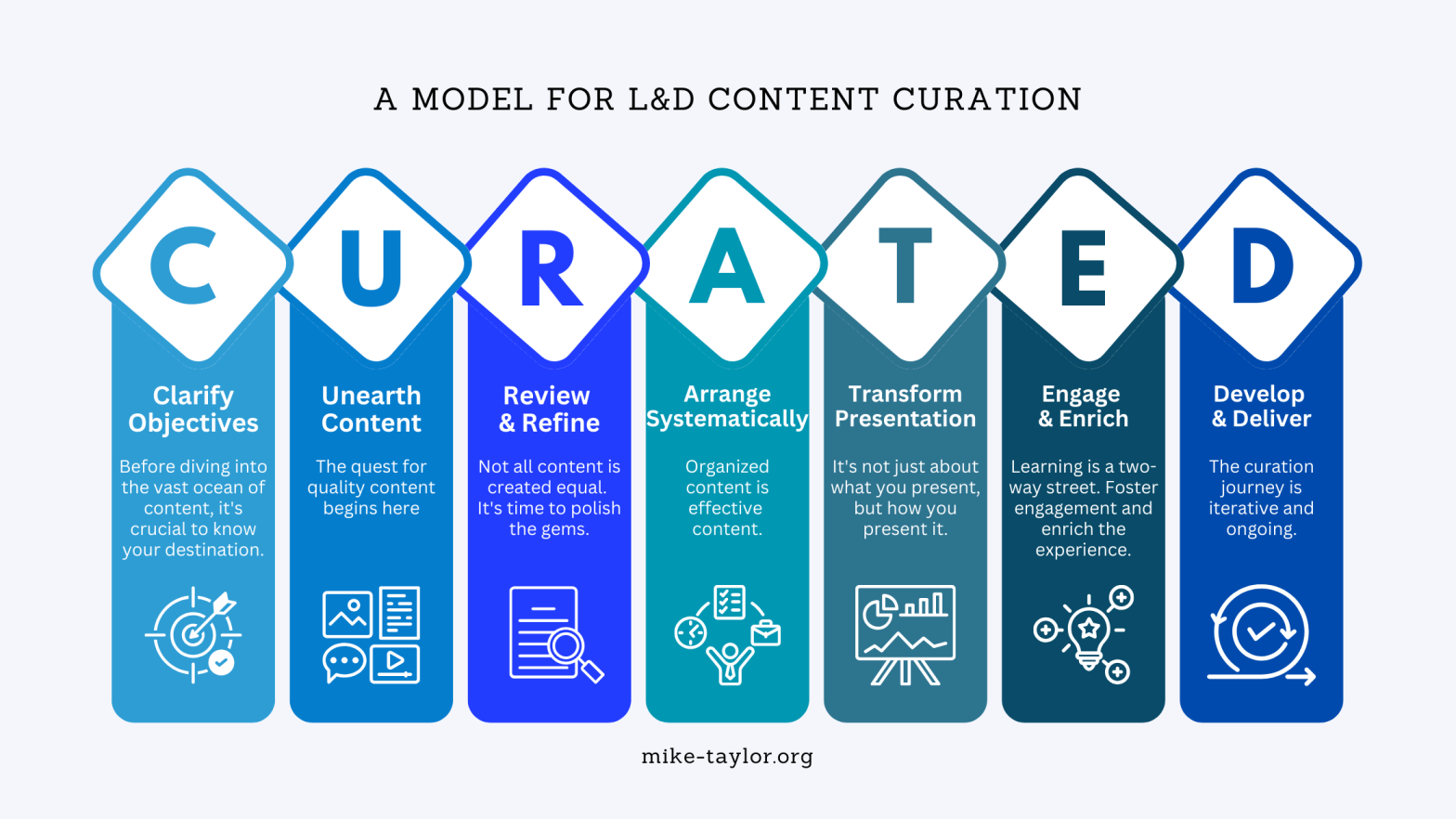Here’s the thing! At the heart of every great learning professional lies the soul of a curator. Think about it. When we craft our courses, even the formal ones, aren’t we sifting through mountains of info, hand-picking the golden nuggets, and then serving them up in a tasty, digestible format? That’s curation! If you’ve ever designed any learning, you’ve already got this skill, even if you haven’t realized it. We’re all in this curation game together, whether we know it or not.
Creating engaging and effective learning content requires thoughtful curation. That’s why I’ve developed the C.U.R.A.T.E.D. model for curating learning content. C.U.R.A.T.E.D. provides a structured framework to guide you through the process of curating content for learners.
In the world of Learning & Development (L&D), the challenge isn’t just about creating content—it’s about curating it. With the digital age showering us with a deluge of information, how do L&D professionals sift through the noise and select the gold?
Enter the C.U.R.A.T.E.D. model, a systematic approach designed to elevate your content curation game. If you’re an L&D professional, this model is your roadmap to curation success.

| C | Clarify learning objectives based on needs assessments and goals |
| U | Unearth relevant content via research, recommendations & user-generated sources |
| R | Review and refine the content for relevance, accuracy, engagement & diversity |
| A | Arrange content systematically into logical categories, sequences & integrations |
| T | Transform the presentation for the delivery platform & optimize the user experience |
| E | Engage learners through interactivity, feedback loops & social learning |
| D | Develop & deliver curated content while incorporating ongoing reviews & feedback |
The C.U.R.A.T.E.D. model takes the guesswork out of curation. By following this step-by-step approach, you can create customized learning experiences that meet learner needs. The model is flexible enough to work for curating all types of content, from articles to videos to podcasts and more. Let’s take a deeper dive into each step of the process.
C – Clarify Objectives:
Navigating the vast ocean of content can be overwhelming, so it’s essential to have a clear destination in mind before you set sail. Think of it as charting a course for a journey.
- Needs Assessment: Begin by understanding the learning needs of your audience. What are their knowledge gaps? What skills do they seek? This foundational step ensures that your curation efforts are laser-focused on what truly matters.
- Learning Goals: With a clear understanding of needs, define your learning objectives. What should learners take away from the content? Setting clear, measurable goals ensures that your curation efforts align with desired outcomes.
U – Unearth Content:
The quest for quality content begins here.
- Research: Dive deep into search engines, academic databases, industry publications, and other trusted sources. The digital world is your oyster, but remember to pick pearls.
- Recommendations: Leverage the collective intelligence of your network. Encourage peers, experts, and even learners to suggest valuable content. Often, the best insights come from collaborative efforts.
- User-Generated Content: Don’t overlook the potential of content created by learners or employees. From insightful blogs to in-depth discussions, user-generated content can be a treasure trove of knowledge.
This is where being ruthlessly efficient with your information diet really pays off.
Learn more in “How I Create My Weekly Newsletter (and personal curation tips you should steal)“
R – Review & Refine:
Not all content is created equal. It’s time to polish the gems.
- Relevance: Ensure that every piece of content aligns with your learning objectives. If it doesn’t serve a purpose, it doesn’t make the cut.
- Accuracy: In the age of misinformation, fact-checking is non-negotiable. Ensure that your content is accurate, credible, and up-to-date.
- Engagement: Dry, dull content is the nemesis of learning. Opt for content that captivates, inspires, and resonates with your audience.
- Diversity: A diverse content mix—videos, articles, podcasts, infographics—enriches the learning experience, catering to various segments of your audience.
A – Arrange Systematically:
Organized content is effective content.
- Categorization: Group content into coherent modules or topics, making it easier for learners to navigate and digest.
- Sequencing: Like a well-told story, your content should flow logically, building on previous knowledge and setting the stage for what’s next.
- Integration: Ensure that different content pieces complement and reinforce each other, creating a cohesive learning journey.
T – Transform Presentation:
It’s not just about what you present, but how you present it.
- Platform Selection: Choose the right platform to host your content, be it an LMS, intranet, curation platform or a dedicated website.
- User Experience: Prioritize easy navigation, searchability, and a design that’s responsive across devices.
- Repurose: Adapting content from one format to another, like converting an in-depth article into a succinct slideshow, can broaden its appeal, making essential points more accessible and captivating to a wider audience.
E – Engage & Enrich:
Learning is a two-way street. Foster engagement and enrich the experience.
- Annotation: Enhance content with notes, summaries, or guiding questions, providing context and highlighting key takeaways.
- Interactivity: Weave in quizzes, discussions, and assignments to make learning active, not passive.
- Feedback Loop: Empower learners to share feedback, ensuring that the content remains relevant and impactful.
- Social Learning: Promote discussions, peer reviews, and group activities, harnessing the power of collaborative learning.
D – Develop & Deliver:
The curation journey is iterative and ongoing.
- Regular Review: Periodically revisit your content, ensuring it remains fresh and relevant.
- Incorporate Feedback: Adapt and evolve based on feedback, making your content even more aligned with learner needs.
- Stay Updated: The L&D landscape is ever-evolving. Stay abreast of industry trends, technological advancements, and pedagogical innovations.
In conclusion, the C.U.R.A.T.E.D. model is more than just a content curation strategy—it’s a philosophy. It champions a holistic, learner-centric approach, ensuring that every piece of content serves a purpose and adds value. As L&D professionals, our mission is to facilitate meaningful learning experiences, and with the C.U.R.A.T.E.D. model, we’re one step closer to achieving that goal. Embrace it, implement it, and watch your L&D initiatives thrive.

6 thoughts on “The C.U.R.A.T.E.D. Model Can Help Anyone Master Content Curation”